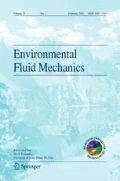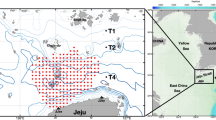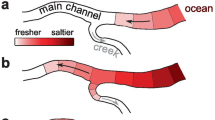Abstract
Tidal vortices play an important role in the flushing of coastal regions. At the mouth of a tidal inlet, the input of circulation by the ebb tide may force the formation of a starting-jet dipole vortex. The continuous ebb jet current also creates a periodic sequence of secondary vortices shed from the inlet mouth. In each case, these tidal vortices have a shallow aspect ratio, with a lateral extent much greater than the water depth. These shallow vortices affect the transport of passive tracers, such as nutrients and sediment from the estuary to the ocean and vice versa. Field observation of tidal vortices primarily relies on ensemble averaging over several vortex events that are repeatable in space and can be sampled by a fixed Eulerian measurement grid. This paper presents an adaptive approach for locating and measuring within tidal vortices that propagate offshore near inlets and advect along variable trajectories set by the wind-driven currents. A field experiment was conducted at Aransas Pass, Texas to measure these large-scale vortices. Locations of the vortices produced during ebb tide were determined using near real-time updates from surface drifters deployed near or within the inlet during ebb tide, and the paths of towed acoustic Doppler current profiler (ADCP) transects were selected by analysis of the drifter observations. This method allowed ADCP transects to be collected within ebb generated tidal vortices, and the paths of the drifters indicated the presence of both the starting-jet dipole and the secondary vortices of the unstable ebb tidal jet. Drifter trajectories were also used to estimate the size of each observed vortex as well as the statistics of relative diffusion offshore of Aransas Pass. The field data confirmed the starting-jet spin-up time (time until the vortex dipole begins to propagate offshore) measured in the laboratory by Bryant et al. [6] and that the Strouhal condition of \(St=0.2\) predicts the shedding of secondary vortices from the inlet mouth. The size of the rotational core of the vortex is also shown to be approximated physically by the inlet width or by \(0.02UT\), where U is the maximum velocity through the inlet channel and T is the tidal period, and confirms results found in laboratory experiments by Nicolau del Roure et al. [23]. Additionally, the scale of diffusion was approximately 1–15 km and the apparent diffusivity was between 2–130 \(m^2/s\) following Richardsons law.















Similar content being viewed by others
References
Adrian RJ, Christensen KT, Liu Z-C (2000) Analysis and interpretation of instantaneous turbulent velocity fields. Exp Fluids 29:275–290
Berthot A, Pattiaratchi C (2006) Field measurements of the three-dimensional current structure in the vicinity of a headland-associated linear sandbank. Cont Shelf Res 26:295–317
Brown CA, Jackson GA, Brooks DA (2000) Particle transport through a narrow tidal inlet due to tidal forcing and implications for larval transport. J Geophys Res 105(C10):24,141–24,156
Brown CA, Holt SA, Jackson GA, Brooks DA, Holt GJ (2004) Simulating larval supply to estuarine nursery areas: how important are physical processes to the supply of larvae to the Aransas Pass inlet? Fish Oceanogr 13(3):181–196
Brown CA, Jackson GA, Holt SA, Holt GJ (2005) Spatial and temporal patterns in modelled particle transport to estuarine habitat with comparisons to larval fish settlement patterns. Estuar Coast Shelf S 64:33–46
Bryant DB, Whilden KA, Socolofsky SA, Chang K-A (2012) Formation of tidal starting-jet vortices through idealized barotropic inlets with finite length. Environ Fluid Mech 12(4):301–319
Canals M, Pawlak G, MacCready P (2009) Tilted baroclinic tidal vortices. J Phys Oceanogr 39:333–350
Cochrane JD, Kelly FJ (1986) Low-frequency circulation on the Texas–Louisiana continental shelf. J Geophys Res 91(C9):10,645–10,659
Csanady GT (1980) Turbulent diffusion in the environment. D. Reidel, Dordrecht, p 100–104
Geyer WR (1993) Three-dimensional tidal flow around headlands. J Geophys Res 98(C1):955–966
Geyer WR, Signell R (1990) Measurements of tidal flow around a headland with a shipboard acoustic doppler current profiler. J Geophys Res 95(C3):3,189–3,197
Hench JL, Blanton BO, Luettich RA Jr (2002) Lateral dynamic analysis and classification of barotropic tidal inlets. Cont Shelf Res 22:2615–2631
Hench JL, Luettich RA Jr (2003) Transient tidal circulation and momentum balances at a shallow inlet. J Phys Oceanogr 33:913–932
Holt SA, Holt GJ, Arnold CR (1989) Tidal stream transport of larval fishes into non-stratified estuaries. Rapp PV Réun Cons Int Explor Mer 191:100–104
Jeppesen Marine, Inc. (2006) Nobeltec Tides & Currents User’s Guide. Jeppesen Marine, Inc. http://ww1.jeppesen.com/documents/marine/light-marine/TC_Users_Guide. Accessed 10 June 2013
Kashiwai M (1984) Tidal residual circulation produced by a tidal vortex. Part 1. Life-history of a tidal vortex. J Oceanogr Soc Jpn 40(4):279–294
Kashiwai M (1985a) TIDICS-Control of tidal residual circulation and tidal exchange in a channel-basin system. J Oceanogr Soc Jpn 41(1):1–10
Kashiwai M (1985b) A hydraulic experiment on the tidal exchange. J Oceanogr Soc Jpn 41(1):11–24
LaCasce JH (2008) Statistics from Lagrangian observations. Prog Oceanogr 77:129
McFarland, WN (1961) Seasonal plankton productivity in an offshore south Texas beach. Coastal Fisheries 1960–1961: Marine Fisheries Division, Texas Game and Fish Commission. http://coastal.tamug.edu/CoastalFisheries/1960-1961/CoastalFisheries1960-1961-McFarland01. Accessed 9 January 2013
McNally GJ, Patzert WC, Kirwan AD, Vastano AC (1983) The near-surface circulation of the North Pacific using satellite tracked drifting buoys. J Geophys Res 88:7507–7518
Monin AS, Yaglom AM (1975) Statistical Fluid Mechanics: mechanics of Turbulence, Vol 2, MIT Press, Cambridge. p 551–567
Nicolau del Roure F, Socolofsky SA, Chang K-A (2009) Structure and evolution of tidal starting-jet vortices at idealized barotropic inlets. J Geophys Res-Oceans 114:C05024
National Oceanic and Atmospheric Administration (NOAA), National Ocean Service (NOS), Office of Coast Survey, and the Strategic Environmental Assessments (SEA) Division of the Office of Ocean Resources Conservation and Assessment (ORCA) (1994) NOS80K—medium resolution digital vector U.S. Shoreline shapefile for the contiguous United States. NOAA/NOS/ORCA/SEA. http://coastalmap.marine.usgs.gov/GISdata/basemaps/coastlines/nos80k/nos80k.html. Accessed 25 February 2011
National Data Buoy Center (2012) Station PTAT2—Port Aransas, TX. National Oceanic and Atmospheric Administration. www.ndbc.noaa.gov/station_page.php?station=ptat2. Accessed 1 November 2012.
National Data Buoy Center (2013) Station RTAT2—Port Aransas, TX. National Oceanic and Atmospheric Administration. www.ndbc.noaa.gov/station_page.php?station=rtat2. Accessed 20 January 2014.
Ohlmann JC, White PF, Sybrandy AL, Niller PP (2005) GPS-cellular drifter technology for coastal ocean observing systems. J Atmos Oceanic Technol 22:1381–1388
Pacific Gyre, Inc. (2010) Microstar specification sheet. Pacific Gyre, Inc. http://pacificgyre.com/files/microstar. Accessed 11 June 2013
Pawlak G, MacCready P, Edwards KA, McCabe R (2003) Observations on the evolution of tidal vorticity at a stratified deep water headland. Geophys Res Lett 30(24):2,234
Richardson LF (1926) Atmospheric diffusion shown on a distance-neighbour graph. Proc R Soc Lond A 110(756):709–737
Rockwell D (2008) Vortex formation in shallow flows. Phys Fluids 20:031303-1–031303-8
Roughan M, Mace AJ, Largier JL, Morgan SG, Fisher JL, Carter ML (2005) Subsurface recirculation and larval retention in the lee of a small headland: a variation on the upwelling shadow theme. J Geophys Res 110:C10027
Spiers KC, Healy TR, Winter C (2009) Ebb-jet dynamics and transient eddy formation at Tauranga Harbour: implications for entrance channel shoaling. J Coastal Res 25(1):234–247
Sponaugle S, Lee T, Kourafalou V, Pinkard D (2005) Florida current frontal eddies and the settlement of coral reef fishes. Limnol Oceanogr 50(4):1,033–1,048
Stabeno PJ, Reed RK, Overland JE (1994) Lagrangian measurements in the Kamchatka current and Oyashio. J Oceanogr 50:653–662
Takasugi Y, Hoshika A, Noguchi H, Tanimoto T (1994a) The role of tidal vortices in material transport around straits. J Oceanogr 50:65–80
Takasugi Y, Fujiwara T, Sugimoto T (1994b) Formation of sand banks due to tidal vortices around straits. J Oceanogr 50:81–98
Thomson RE, LeBlond PH, Ravinovich AB (1997) Oceanic odyssey of a satellite-tracked drifter: North Pacific variability delineated by a single drifter trajectory. J Oceanogr 53:81–87
Wells MG, van Heijst G-JF (2003) A model of tidal flushing of an estuary by dipole formation. Dyn Atmos Oceans 37:223–244
Whilden KA (2009) Laboratory analysis of vortex dynamics for shallow tidal inlets, M.S. thesis, Department of Civil Engineering, Texas A&M University, College station
Wolanski E, Drew E, Abel KM, O‘Brien J (1988) Tidal jets, nutrient upwelling and their influence on the productivity of the alga Halimeda in the Ribbon Reefs, Great Barrier Reef. Estuar Coast Shelf S 26:169–201
Yanagi T, Murashita K, Higuchi H (1982) Horizontal turbulent diffusivity in the sea. Deep-Sea Res 29(2A):217–226
Zhang Z, Hetland R (2012) A numerical study on convergence of alongshore flows over the Texas–Louisiana shelf. J Geophys Res 117:C11010
Acknowledgments
Financial support for this research was provided by the Texas Sea Grant College Program (NA06OAR4170076). The authors would like to thank Mr. David Dailey, Ms. Melanie Truong, Ms. Maryam Rezvani, and Mr. Nick Cox for their assistance in collecting the field data. In addition, the authors would also like to thank Mr. Frank Ernst and Mr. John Turany from the University of Texas Marine Science Institute for operating the research vessel.
Author information
Authors and Affiliations
Corresponding author
Rights and permissions
About this article
Cite this article
Whilden, K.A., Socolofsky, S.A., Chang, KA. et al. Using surface drifter observations to measure tidal vortices and relative diffusion at Aransas Pass, Texas. Environ Fluid Mech 14, 1147–1172 (2014). https://doi.org/10.1007/s10652-014-9361-4
Received:
Accepted:
Published:
Issue Date:
DOI: https://doi.org/10.1007/s10652-014-9361-4




